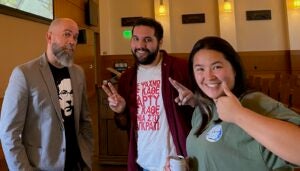
Think about how you move about your day and the kind of trash you produce. For many of us, single-use objects make up the majority of our discards daily, whether it be a plastic Starbucks cup after a grande macchiato or the container of the pre-made Trader Joe’s salad that you bought because you forgot your lunch. Whatever it may be, we tend to discard these things without giving them a second thought, partly because they were designed with that thought in mind and another part because we have not imbued them with enough significance to even consider what a “proper” disposal might look like. Now, imagine you find yourself in a situation where everything in your childhood home, a place riddled with significance, was discarded just like the plastic cup from your morning coffee. Both things got thrown away, but the discard from your family home holds significantly more value than the cup you tossed this morning yet, in throwing it away, we are essentially doing the same thing to both objects, stripping them of their histories. Anthropologist and Associate Professor Anthony Graesch of Connecticut College sees the value of these objects and has come to share his insights and projects going forward that further explore this uncovering of the history of an object as well as assessing our 21st-century attitude and actions toward discard.
During his lecture this past Wednesday, October 23rd entitled “Till Death Do We Part: Exploring the Archaeology of Modern Discards”, Graesch brought to our attention the the concept of discard studies, a field that applies archaeological theories and methods to modern objects and waste. He argues that studying material waste and how we dispose of our waste reveals a lot about our behaviors throughout life and how we view the things we own. His most ambitious project aims to support these claims further and provide new interdisciplinary methods of studying discard using both ethnographic and archeological techniques.
The project in question is called Archaeological Interventions in Contemporary Discard and it delves into what Graesch calls “massive purges” of household inventories. These purges are often tied to major life transitions—events such as the death of a family member, divorce, retirement, or a move to a smaller living space. These events offer fertile ground for archaeologists because they reveal much about our relationship with material goods. Graesch’s studies observe how families or individuals engage with objects that once held sentimental value, from childhood keepsakes to inherited heirlooms. Graesch, and his team of anthropology and archaeology undergrads, deploy a variety of methods, including “archaeological intervention” which involves physically interceding in the discard process, documenting what brings objects to their disposal sites, and how people experience letting go. This process reveals that discarding is not merely an action but a ritual, one that often involves what Graesch calls a “willful severance”—a final, decisive act of parting from our material ties.
By documenting these massive purges, Graesch’s work highlights how contemporary consumer culture shapes our discard behaviors and the psychological weight of large-scale disposals. For archaeologists, these events provide a rare opportunity to explore how people construct and deconstruct the material scaffolding of their lives, and how those actions reflect changing societal values around possession, memory, and identity. Graesch’s explorations further enrich the great old saying “One man’s trash is another man’s treasure”.